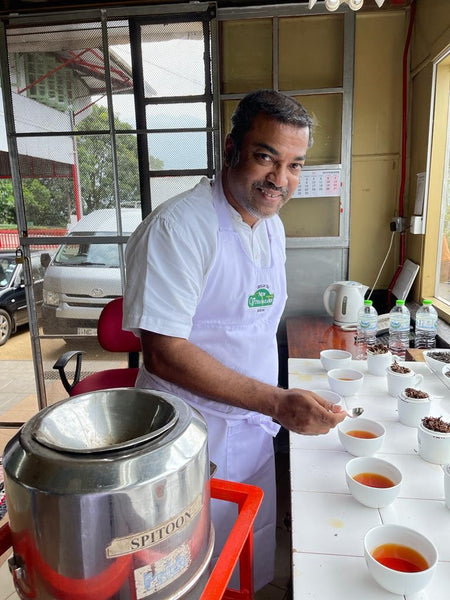What is Ceylon Tea?

Much like wine, tea has its own rules about names, and just like wine, the rules don't always make much sense. Some teas, like White Peony, are named after a specific production style and plucking standard. For others, the name may be determined by when the tea was harvested, such as first and second flushes from Darjeeling. Then there are teas—in a diverse range of styles or grades—named after where they are made.
Such is the case with Ceylon tea. If your tea was grown in Sri Lanka, it's Ceylon, no matter the type. "Ceylon" is an English spin on Ceilão, which is what the Portuguese called the island in the 16th century. But there's more to it than that. The island of Sri Lanka is one of the world's largest tea producing nations by volume. A lot of tea gets made there, and it's not all the same!
Generally, when people talk about Ceylon tea, it refers to a rich and sunny black tea that's typically darker than Darjeeling, but lighter than Assam. It was English colonial planters who brought tea to Sri Lanka from India, and they took their production methods with them. Darjeeling, Assam and Ceylon are all considered "orthodox" black teas, a handpicked style refined by the British in the 19th century that was loosely based on Chinese techniques, but scaled up for greater volumes.
The 20th century saw gardens in all these regions experiment with styles beyond fully oxidized orthodox. Sri Lanka today produces lots of green and white tea, and these too may be called Ceylon. In this article, though, we are referring to traditional orthodox black breakfast-style tea.

Tea grows throughout Sri Lanka, from low-lying coastal areas to misty hilltops 6,000 feet above sea level. Leaves from high elevation gardens are often considered the best quality (similar to some teas from India and China), though that's a big generalization. Regardless of elevation, all Ceylon tea makers sort their teas by shape and size, from premium whole leaf to tiny fanning particles destined for filling teabags.
These sorted categories are called grades, and they speak less to the innate quality of a tea than they act as shorthand for professional tea buyers about what to expect from a given batch. The Tea Exporters Association of Sri Lanka notes 16 different main grades for orthodox Ceylon tea, ranging from D for "Dust" to FBOPFEXSP for "Flowery Broken Orange Pekoe Fannings Extra Special." The term "Orange Pekoe" isn't a style of tea, per se; it's a grade of tea.
Our Ceylon Orange Pekoe hails from the New Vithanakande Estate, outside the city of Ratnapura on the south end of the island. It's an FBOPFEXSP, the garden's highest grade, representing 1% of their annual production. We've enjoyed New Vithanakande's teas since IPOT's early days and are proud to share this singular, unblended lot. It's unusually rich and sweet for a Ceylon, with distinct notes of sun-dried tomato and buttered brioche toast, and a luxurious texture thanks to the ample golden buds. The beautiful handpicked leaves exhibit undeniable craft in both plucking and processing.

Marketing manager Chamikara Pilapatiya describes this lot as one of the garden's reserve products. When a particularly good harvest comes in, workers may whisk away the top grade finished material to add to this reserve until they've accumulated enough tea to sell in a single batch. Remember, this is the garden's cream of the crop; it can take months of selection to yield enough leaf for the special grade.
New Vithanakande is a low elevation garden, and the tea for our Ceylon Orange Pekoe grows at around 600 feet above sea level. Interestingly, Pilapatiya explains that gardens at different elevations follow different business models. The high elevation gardens mostly adhere to the British plantation standard, where a garden owns all of its field outright, and provides lodging and meals for workers who live on the estate. Low elevation gardens like New Vithanakande only own a fraction of their tea fields, and instead buy freshly picked green leaf from independent farmers with their own small plots of land. New Vithanakande works with 6,000 of these family farms throughout the region. The factory provides farmers with seeds, fertilizer and loans for capital improvement projects, as well as training in tea horticulture and plucking standards.
Now, onto the cup: how to best prepare it? We recommend steeping Ceylon with boiling water to fully extract all the good stuff in the leaf. Start with a two- or three-minute steep; go up to five minutes if you want a stronger brew or are planning to add other ingredients. However, do try our Ceylon Orange Pekoe tea on its own at least once, without milk or sugar. The natural sweetness and balanced finish of this superior black tea may surprise you!
Try our Ceylon Orange Pekoe from the New Vithanakande Estate
Photos of New Vithanakande factory and Chamikara Pilapatiya courtesy of New Vithanakande Tea Estate.
